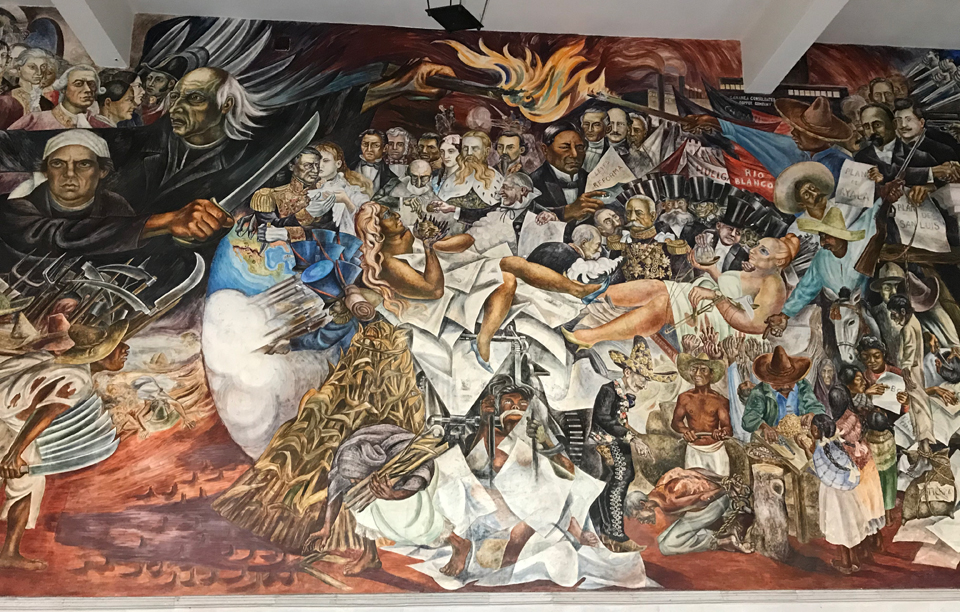
AGUASCALIENTES, Mexico—Now that I have a Mexican husband (as of our marriage in Zacatecas last May), I’ll be traveling there more frequently, providing us time to spend together while awaiting U.S. governmental decision on his ability to join me in Los Angeles, opportunity to improve my Spanish, and the chance to share occasional “postcard” impressions of the country with our readers.
Juan José, born and raised in Zacatecas, a city and state in central Mexico, returned there from Los Angeles in late 2017 to reconnect with his family. It’s a lovely old colonial-era city that’s been designated a UNESCO World Heritage site, which is both a distinction and a burden. My husband happens to be blind—completely so for about the last ten years—and the ancient cobbled streets winding over hilly terrain that look so charming in their casual disrepair to the foreign visitor are often treacherous for someone tapping his route to almost anywhere in town.
Added to which, Mexico, in general, falls somewhat behind the standards that have evolved in the U.S. for accommodating the disabled. Ramps and handrails are not universally mandated. In the middle of a sidewalk, stairs can suddenly appear, rising or descending on a pitched slope, or jutting out into the walkway as the stepping stone into a doorway. Anyone using a wheelchair would have an exceedingly difficult time getting around.

Juan José has recently transferred his home base to Aguascalientes, a city (and state) just short of a two-hour bus ride from Zacatecas, close enough that if he had to, he could travel back and forth in one day. He also has relatives there, and for some years in his childhood lived there, so he knows the layout of the city almost equally well.
Aguascalientes sits in a broad valley. Although surrounding the city are low hills and rocky outcroppings amidst a semi-desert landscape punctuated by the profiles of flourishing yucca cacti, the central urban area of the state capital is almost entirely flat. It’s far easier for him to get to know his new neighborhood and to start learning the public transportation system, without all the loose cobblestones underfoot.
Yet another serious problem for a blind pedestrian is a frequent occurrence: Inattention to overhanging branches and bushes, which can give a person using a cane a serious wallop as they are innocently trying to negotiate a sidewalk. This is, of course, a common issue in the U.S. as well. I advised Juan José to carry a clippers and a saw when he goes out walking, to take direct action at the source of the problem and teach these property owners a lesson!
He also points out that while many sidewalk corners in Aguascalientes have cut-out ramps for both pedestrians and wheelchairs, far more than in Zacatecas, it’s frequent that one can step down a ramp into the intersection, but not find a corresponding ramp up on the other side of the street. Fortunately for him—though not so much for wheelchair users—he is adept enough with his cane to recognize a curb and pace himself appropriately.
Public transportation in the form of buses—there is no metro system in either Zacatecas or Aguascalientes—is neither free for the blind nor especially convenient, though I have heard and witnessed that people on the street are generally helpful directing a blind person to a bus stop and even waiting with them to make sure they board successfully.
Blind and otherwise disabled persons are rarely seen on the streets, and not only owing to the lack of accommodations. Disability still carries some stigma, and family members tend to overprotect their disabled relations from outside exposure. According to a survey conducted by a group called Ciegos Progresistas (the Progressive Blind) of Aguascalientes, the major problem confronting blind people there is the lack of opportunity for work, although of course there are many jobs and professions blind people can perform competently and creatively if given the chance.
Disabled Mexicans take some encouragement from Hugo Ruiz, a blind member of Congress from the MORENA party, who has made it his priority to lift the status of his nation’s fellow disabled citizens. In the meantime, however, a modest disability benefit for which Juan José applied two years ago has still not come through: For the first year, in Pres. Enrique Peña Nieto’s time, it’s possible that his payments were credited to some bureaucrat’s private account considering the widespread corruption that reigned. But it’s now been another whole year, under new MORENA President Andrés Manuel López Obrador, and still nada. Anecdotal intelligence, perhaps, but indicative that a change of personnel and party at the top does not always translate into instantaneous correction of abuses.
At a family breakfast gathering at which I was introduced to a branch of Juan José’s relatives, a primo político (a cousin-in-law, which introduced to me a secondary meaning to the word político) asked me point blank if I was a leftist, centrist or rightist—an izquierdista, centrista o derechista. I unabashedly replied “izquierdista,” at which point our hostess deftly diverted the conversation.
The skeleton artist
Possibly the single most recognizable feature of Mexican art is the ubiquitous presence of skeletons. Sources for that obsession go back equally to constant Roman Catholic reminders of human mortality in the iconography of the Church (think Adam’s skull often found at the base of the crucifix) and to pre-Columbian deities both humanoid and animal with skeletal parts.
In the 19th century, the great printmaker José Guadalupe Posada more than anyone else interpreted Mexican society, politics, and culture through the hollow eyes of his skeleton figures engaged in every aspect of life, attired and satirized as politicians, priests, upper-class gowned ladies, musicians, and people of all classes. His Catrina figure, crowned by a broad, flowery hat with ribbons and lace, and dressed in flowing, billowing skirts, has become a permanent cultural icon.
Posada, whose work I have known since my college days, was a native of Aguascalientes, born there in 1852. From murals, statues and artisanal offerings in the marketplace, it’s apparent that he still exerts a powerful presence in the city. The José Guadalupe Posada Museum, established in 1972 as the first art museum in the state, occupies an impressive building attached to the Nuestro Señor del Encino church adjacent to a lovely, well-kept public garden in downtown Aguascalientes. In fact, the facility had been confiscated from the church after the Mexican Revolution. It is chock-full of his prints and images that originally appeared in newspapers both here and in Mexico City, where he established himself in his twenties.

Little escaped Posada’s notice. He informed and entertained the public with his amusing pictures that illustrated news-breaking broadsides called corridos, and stories of passionate crimes and weird births. He captured the extreme vividness and violence of life, with its tales of love, misery, greed, power, and death. His graphic art is known throughout the world: His lurid smiling skeletons have never ceased to mock the living from the world of the dead. He lived long enough to document the Mexican Revolution with his unique vision, capturing the early rebel leaders with his caustic imagery.
The museum has a section devoted to other printmakers’ work, winners of a periodic competition conducted in Posada’s name to encourage the art of printmaking. One charming installation in the central courtyard has several of Posada’s original woodblock designs reproduced in metal so that visitors can make their own rubbings on paper with crayons supplied by the museum in different colors.
Posada is quite possibly the city’s (and state’s—they both bear the same name) most famous hidrocálido. If someone from Zacatecas is a zacatecano, and from Oaxaca a oaxaqueño, and from Yucatán a yucateco, Aguascalientes, meaning “hot waters,” is kind of an awkward name to adapt. So sometime long ago the classically trained city fathers decided to take the Greek for water and the Latin for hot to turn a person from the state into an hidrocálido. It was a source of amusement for me. For what it’s worth, now you know.
Navidad en México
It being the Christmas season, I couldn’t help noticing that so much of the décor and the music heard in churches, malls and on TV were imported from North America. Images of Santa Claus, the reindeer and the sleigh could be seen everywhere. People whose homes I visited decorated them obsessively as though we had suddenly passed into some dreamlike, overcrowded North Pole wonderland workshop. Cities created a festive atmosphere down the callejones, little streets covered from rooftop to rooftop with twinkling Christmas lights. On larger streets, they would erect whole arched canopies of lights a block long for pedestrians to enjoy, free of vehicles. Wherever the nativity scene was created, in homes, restaurants, public squares or houses of worship, the crib for the expected baby was always left empty until midnight on December 24.
Popular Christmas songs like “Jingle Bells,” “Chestnuts Roasting on an Open Fire,” and “I’m Dreaming of a White Christmas,” resounded on soundtracks across the land, in Spanish translation. The unison chorus with a little backup band at Our Lady of Fátima Church in Zacatecas, where we spent Christmas Eve, performed the latter song; I may have been the only person in the packed sanctuary whose thoughts turned to its Jewish composer writing that ca. 1940 song that refers to a fine sunny day in Beverly Hills as he reminisces about the snowy winters of his youth.
I saw something for the first time here, though it’s probably not news to many practicing Catholics: Women trained as “ministers” in the Catholic Church performing communion duty, a sign of recent reforms enacted under Pope Francis. Church leaders passed out aguinaldo to the kids (and lots of adults too)—packages of peanuts and Mexican junk food, sweets and goodies, some with native flavors such as tamarind and spicy hot peppers. Lots of plastic wrapping and containers! Aguinaldo is also the term for the Christmas bonus that employees receive each December.
When we went to Christmas Eve dinner at Juan José’s sister’s house later that night, I was gratified to watch kids’ animated videos with karaoke singalong verses of some of the traditional Spanish villancicos for Navidad: Not all has been lost to cultural hegemonism from the Norte!
A walk around town
As in most cities founded by the Spanish, the central plaza, or zócalo, is the focal point of the Aguascalientes community. Around it are situated the Cathedral, the Palacio Municipal, the Teatro Morelos and the Palacio de Gobierno.
The latter is a grand two-story structure whose arched passageways are lined with colorful murals depicting aspects of local and national history. Sections of them were painted at different times by a variety of artists, including some from abroad, but the overall esthetic clearly shows the Diego Rivera influence. Panoramic scenes portray notables from every period of the area’s past, including the pre-colonial, incorporating folklore and mythology. Tableaux of men gathered at important meetings feature portraits that I am sure could be individually identified. There is probably a book or brochure explaining everything, but I didn’t need to know all the details.
Fitting for a city where Posada got his start, these murals are full of satire directed against the plutocrats and self-important of their time. Showing remarkable freshness and audacity, they also include both female and male nudity, including a famous, historically-based courtesan whose favors were renowned among the city’s well-to-do captains of capital accumulation. Alongside side these panels, too, there are sweet, but not romanticized representations of popular bars and cantinas, with their lively musicians and anonymous dancing couples.
We stopped into the resplendent Cathedral to take a look, and to rest our tired feet. On a Monday afternoon, there were far more people both sightseeing and seated than I would have expected. It turned out that a small funeral service was in progress, with music, prayer, and a comforting eulogy from the priest. I heard a gentle, prayerful tune played on the organ and smiled when I recognized it as “Hatikvah,” the Israeli national anthem!
Snapshots

In Juan José’s neighborhood, the streets are all named for Latin American countries and cities—Peru, El Salvador, Nicaragua, Honduras, Chile, Argentina. Uruguay, etc., as well as Lima, Rio de Janeiro, Montevideo, Buenos Aires, and others. These provide a kind of naturally occurring geography lesson for residents, constantly reminding them of solidarity. Each of those names summons up history and struggles. I suspect Mexican school children have an easier time identifying the different countries of the world on a map than our kids do.
Something else you see on just about every other block: Large city trash bins that are emptied daily. Aguascalientes is rightfully proud of its recent designation as “the cleanest city in Latin America.” Obviously, when people have a place just a few steps from their front door to drop their refuse, most will gladly comply to keep their neighborhood tidy.
One of Juan José’s early discoveries in his neighborhood, actually right across a busy avenue from his house, is the local cocina económica, a small restaurant/kitchen open five days a week that prepares a selection of healthful daily menu offerings. For about $2.50 he can either eat there or take back home large portions of tasty meat, vegetables, soups, and salads. I was eager to try some of these ladies’ dishes, which Juan José had described on our daily phone calls, and they did not disappoint. Knowing that crossing the boulevard alone could be dangerous for him, they gladly take his order that he can call in, and run over to make a home delivery! So here and there, amidst the paucity of public services for disabled people, private citizens do fill in with kind gestures.

We had a chore to complete while in Zacatecas, a document that the U.S. Department of Homeland Security has required for our petition to bring Juan José back to Los Angeles as my husband. I was delighted to learn that copies of Mexican government documents, such as birth, death and marriage certificates, can be easily obtained from a kiosk in a public shopping center. An attendant creates a computerized search for what you need, and presto, there’s your printed document from any jurisdiction in the country, a level of informational organization and public access that I have never seen in the U.S.
Public bathhouses used to be a feature of many cities. Oh, yes, I know what you’re thinking: No doubt there was often a sexual frisson to such an outing, but for the most part, they served an important public health function and still do in places. Cities often did not have running water: Houses and tenements did not have toilets, sinks, and bathtubs. And Aguascalientes—the place of “hot waters”—was known for its healing mineral and salt springs. The most famous bathhouse there is the Thermal Baths of Ojocaliente—an ojo being an “eye” or opening in the earth where the hot waters bubble up. We spent a relaxing hour or so in a meticulously scrubbed private tile pool there one afternoon and afterward watched how many family and social groupings were also enjoying their day there.

Rainclouds were in the skies that day, but we were close by to the Alameda, a long park where traditionally people would come out to stroll and pass the time, and we wanted to see what was there before hopping into a taxi and out of the weather. Amongst the busts of famous hidrocálidos, plantings and benches, we found half a dozen panels, maybe six feet high by fourteen feet long, installed with movable balls colored black on one side and yellow on the other. I’d never seen this in the U.S. Anyone could come along and turn the balls around to create an image, or a girlfriend’s name, or an abstract piece of evanescent art. As the photo shows, someone took it upon themselves to make a political statement.
My guess is that a lower percentage of Mexicans own cars than in the U.S. The interurban bus system is a much used public resource. The Central de Autobuses in any city is a flection point for large numbers of people coming and going, whether to distant locales or just to the next town. We took several trips back and forth from Zacatecas to Aguascalientes, taking advantage when we could of the half-price tickets for seniors (or tercera edad—the “third age,” as they call it). Buses from Zac. to Ags. run every half hour or so for the rarely crowded 105-minute ride, and are equipped with reclining seats, leg rests, a TV console for every passenger, and toilets. Before you board, a woman checks your ticket and you get a choice of soft drink and a snack—chips or a health bar—to enjoy on your trip. It’s very civilized and efficient.

In the last couple of days of my trip, we visited the pueblo mágico of Calvillo, about an hour’s bus ride, on not quite so well appointed a carrier, from Aguascalientes. On this line I was not eligible for a tercera edad discount because I did not hold a Mexican ID—my U.S. passport or driver’s license would not do. The Mexican tourist office has recognized several dozen towns (pueblos) across the country as having special “magical” attraction, either because of their natural beauty lending to recreation, hiking, boating and the like, or because of their well preserved historic, often colonial-era core cities, with precious gardens, charming central zócalos with strolling musicians, and well maintained buildings, museums, hotels, and commercial enterprises. Such towns have a year-round schedule of fairs and holidays to attract visitors.

Calvillo, in the southwest of the small state, is well worth a detour. Its fame derives from long having held the reputation as the Guava Capital of the World. For years the climate here was ideal for growing the guava fruit (called guayaba in Spanish), though in recent times low rainfall has impacted the industry. The state of Michoacán has now overtaken Calvillo in production, though I suspect Calvillo will retain its guava culture and reputation for a long time to come with its special pueblo mágico designation. Specialty shops galore feature a myriad of cookies, pies, empanadas, candies, preserves and even a liqueur all made with guava.
We happened upon a big gathering at the main church off the central plaza: It was baptism day. Mothers and fathers held their infants bundled up in long white dresses for the priest’s blessing. He pronounced an exorcism over the young kids’ souls as he welcomed them into the world.
It was my birthday (a “millstone,” as my dad always used to say), so we stayed overnight and enjoyed a full spa treatment at the hotel: A preparatory tea, terry robes, sauna, steam room, facial and body exfoliants, massages on side-by-side tables, cocktails and a snack by a bubble-bath jacuzzi at sunset, and a bottle of sparkling rosé to enjoy with dinner on the town.
On the return trip, I flew out to Dallas-Fort Worth for my connection back to L.A. As I passed through TSA, I said to the guy, “By the way, you see from my passport I just had a birthday yesterday. Doesn’t that entitle me to something, like not having to remove my shoes anymore when I go through security?”
“It sure does,” he answered cheerily. “And if they say otherwise, you just tell them, ‘Hey, I’ve earned it!’”










